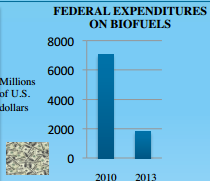
The figure above illustrates recent trends in federal spending on biofuels as a general category, i.e. not differentiated by way of generational status. In sum, the United States has drastically cut federal spending on biofuels over the past few years. From 2010 to 2013 alone, federal allocation of funds to this energy technology declined by a staggering 74%. Seeing as this technology is incredibly dependent on research and development because much of it has yet to be integrated into mainstream energy usage avenues, federal spending is absolutely critical to its successful future.
Again, the status of second-generation fuels as “non-food” sources harbors positive economic consequences. Seeing as major second generation sources include such materials as agricultural and forest residue, oil seed crops, and various flowers, the nonexistence of competition with food items allows for prices (as observed by consumers) to stay low. In other words, the absence of a “food-fuel” dichotomy implies economic betterment as opposed to first generation options. Intuitively, this lack of economic competition presents a clear contrast to certain first generation sources, such as those derived from either corn or soybeans. These commodities, traditionally thought of as foodstuffs, clearly experience a price increase in instances of increased demand hailing from the transportation sector.
(Composed by Robert King, edited by Eli Karp)
References
“Monthly Biodiesel Production Report.” US Energy Information Administration. EIA, 30 Mar. 2015. Web. 14 Apr. 2015.
“Total Biofuels Production and Consumption.” International Energy Statistics– EIA. N.p., n.d. Web. 16 Apr. 2015.
